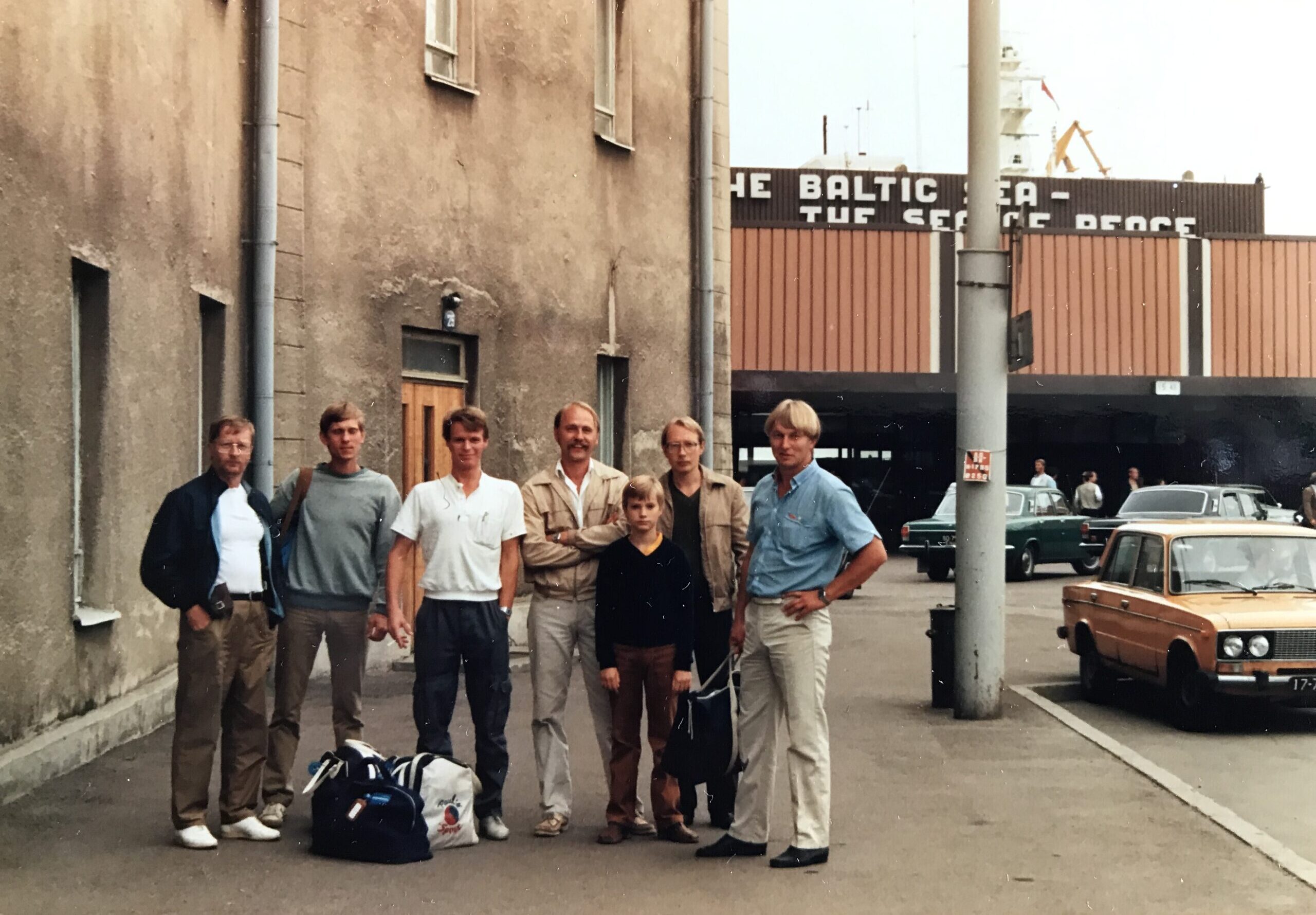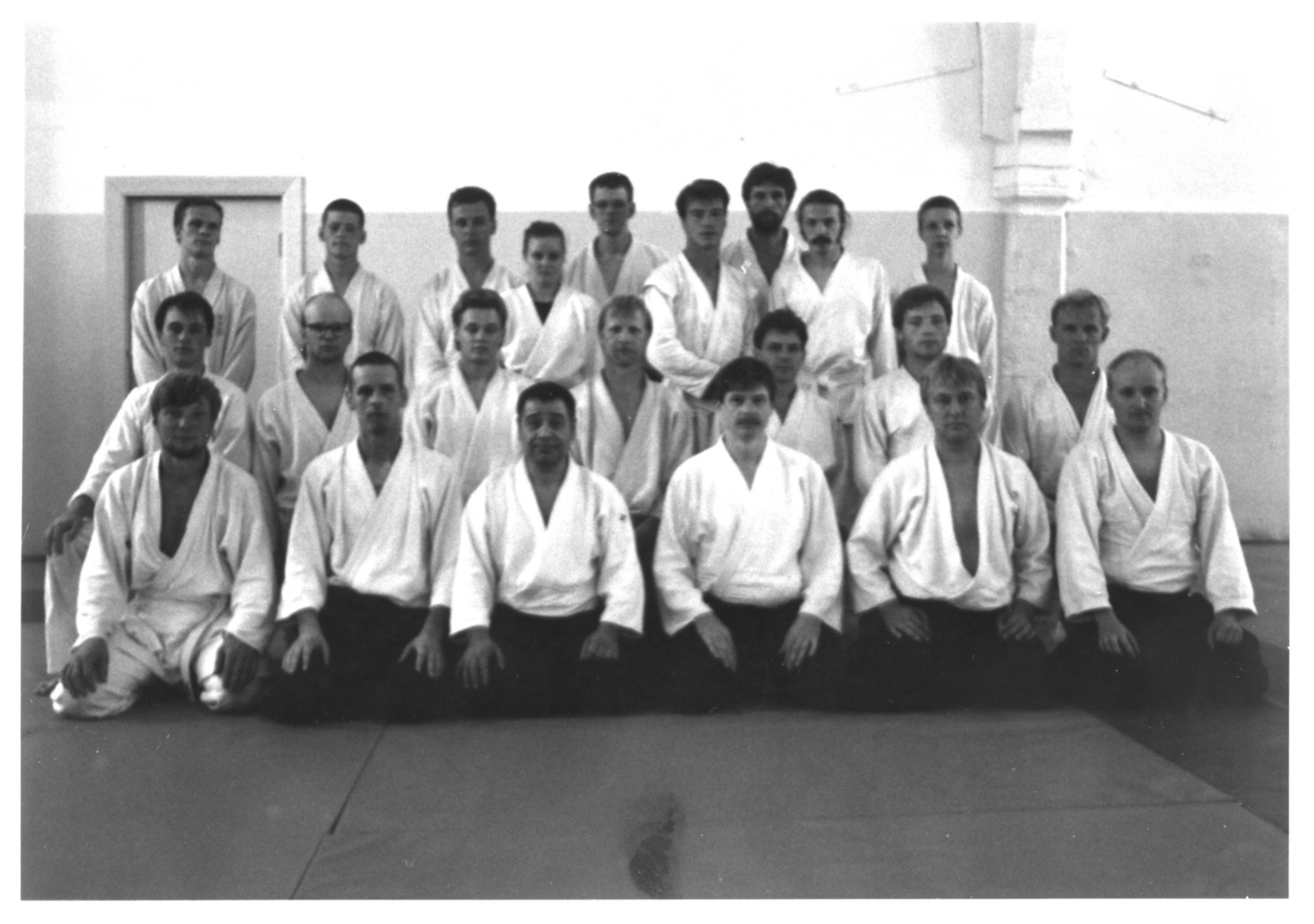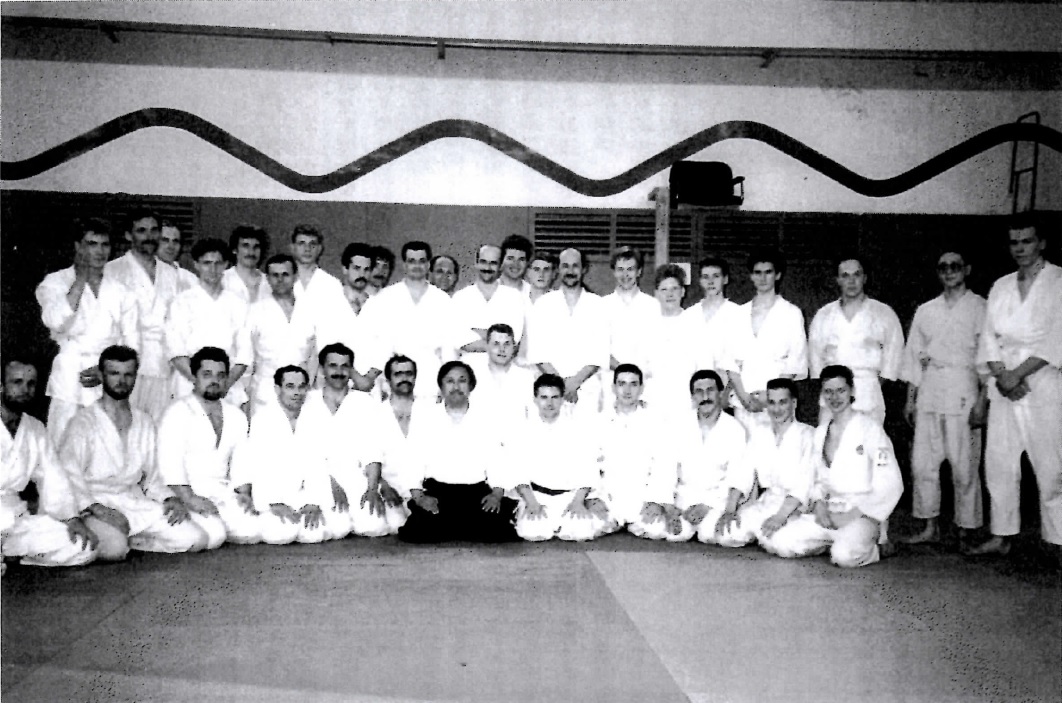How did practicing the Japanese martial art of aikido begin in Estonia?
Aikido is a Japanese martial art that people have been practicing in Estonia for over 30 years. Although we can say that aikido was brought to Estonia by Finns in the 1990s, Japanese masters also visited to conduct seminars as well.
As we know, aikido was first introduced in Estonia by the Finnish aikido instructor Rainer Varis at a karate competition in the early 1980s. Inspired by the presentation, a small group of enthusiasts emerged who wanted to start practicing this seemingly mystical martial art by themselves. Among the first pioneers were Vello Salumets, Janno Põldma, Igor Neemre and Ants Tedresaar. Aikido instructor Rein Ausmees, who joined them later and is still practicing today, remembers that time:
“I first learned about aikido from Sato Nagashima's book "Aikido Basico" in 1981. I saw this art in reality about a year later in Peru and in 1985, I joined the group that had started practicing in Estonia. We practiced techniques copied from available books and videos and we got a lot of help from the Finns, especially Jorma Rissanen and Hannu Juntunen from Kuopio Aikido Club Tenchikan."
The first secret training sessions in changing rooms and basements
Finnish aikido instructor Jorma "Jore" Rissanen recalls that he first heard about aikido in Estonia from his colleague Rainer Varis. When he met Estonian radio journalist Vello Salumets in the mid-1980s, they started to plan together how to support aikido and its practice in Estonia. "Back then, Moscow controlled all sports activities and the only martial arts allowed were judo and wrestling. We started training secretly in changing rooms, basements of apartment buildings and the Pirita Olympic Sailing Centre, which had real tatami mats."
 Right to left - first Jorma Rissanen, next to him Janno Põldma and Vello Salumets
Right to left - first Jorma Rissanen, next to him Janno Põldma and Vello Salumets
Rissanen visited Estonia several times during the Soviet period and helped the enthusiasts to practice basic techniques. Ausmees and Tedresaar later went to training camps in Kuopio at the invitation of the Finns as well and gradually the art began to gain a foothold in Estonia. After Estonia gained independence, organising and visiting training camps became more frequent due to the freedom to travel – great aikido teachers such as Yasuo Kobayashi 8th Dan and Nobuyosi Tamura 8th Dan who had been students of the creator of aikido, Morihei Ueshiba, arrived to lead training camps and teach the enthusiasts. In addition to Rissanen, the Finnish instructors Juhani Laisi and Jukka Helminen became great friends with Estonian practitioners and later organised several seminars in Tallinn.
No one is too old to practice aikido
According to Andrei Dikarev, he first read about aikido in a book by Ljubomir Vračarević, the leader of aikido and the founder of his own branch; the book was brought to him by an acquaintance from the former Yugoslavia in 1987. Having already practiced various types of martial arts before, he took the plunge and started training based on the book and two years later formed a group of enthusiasts. Dikarev's first belt ranking attestations took place in Russia, in what was then called Leningrad. Later, he founded an aikido club called Shogun in Tallinn. Training was conducted together with the club founded by Ausmees and Tedresaar in an unrenovated building on Rüütli Street in Tallinn's Old Town in the 1990s.
The Tallinn Aikido Club was officially registered in 1991. In 1992, in cooperation with the Finnish Aikido Federation, the first demonstration performance and introductory training were organised in Tallinn, which gained a lot of public interest. From then on, a rapid development and creation of clubs occurred. Later in 2006, the MTÜ Eesti Aikidoliit (Estonian Aikido Federation) was founded, which currently represents most of the aikido clubs operating in Estonia.
Andrei Dikarev, Rein Ausmees and Ants Tedresaar can be considered the first Estonian aikido instructors, the latter of whom has unfortunately passed away, but his work is continued by Kalev Liivorg – currently the oldest aikido teacher in Estonia. The Tallinn Aikido Club Taikikai is still operating and three more clubs have developed from it. Also, two aikido clubs in Estonia that are operating today have grown out of Andrei Dikarev's former club.
Kalev Liivorg – once participated as a spectator in a big karate competition, where aikido was demonstrated to Estonian people for the first time. "I liked it and I felt that I would also like to practice this art," he recalls. "In August 1991, I saw an advertisement in the newspaper "Noorte Hääl" that Tallinn Aikido Club was starting admissions. I was 38 years old and I asked instructor Ants Tedresaar if I was too old. I had a good rapport with Ants, I became his main partner and later he made me teach beginners. After Ants's death in 2008, I continued working as an instructor in the club he founded, called Musubi."
Liivorg states that, in his opinion, the coverage area of aikido in Estonia is still small. "However, the Estonian Aikido Federation is alive and well and our enthusiasm has not dissipated," he adds.
The chaotic training sessions and frosty tatami mats of the early years
Aikido enthusiast Allan Voog recalls that he heard about aikido at Lembit Kolk's self-defence courses, where the techniques he saw seemed interesting and effective. In 1991, he, too saw an advertisement in "Noorte Hääl", which invited adults to train at the Tallinn Olympic Sailing Centre. The first class was attended by instructors Rein Ausmees and Ants Tedresaar and four potential practitioners, two of whom are still practicing this art today. The monthly fee was 10 rubles for four training sessions per week. From time to time, Vello Salumets came to the training sessions as a "senior practitioner", demonstrating some more complicated techniques.
"After we had been practicing for about a week, Jorma Rissanen came to give us a seminar. A large part of the crème de la crème of Estonian martial arts practitioners of that time participated at the event and for me it was the first opportunity to see "real" aikido with my own eyes and experience it firsthand. Jorma with his friendly demeanour was definitely one of the reasons I stayed with this art. By the way, Jorma's demonstration performance, which took place as part of this seminar, was seen on “Aktuaalne kaamera," recalls Voog.
Jorma Rissanen's demonstration performance that was broadcasted in „Aktuaalne kaamera“ in 1991
He adds that training in the early days was characterised by great chaos, since the instructors learned together with the students. "What we used to learn and practice for a couple of years in our time is completed in about two months in today's basic courses. In addition, the training was accompanied by quite a bit of fanaticism: we practiced falling by jumping over the back of a chair and self-initiated sword fights often ended with blows to the head. Right from the beginning, an important rule was made clear – if you wanted to develop, you had to attend the classes. And we did, regardless of our state of health or family events!"
 Front row left to right – third Yasuo Kobayashi, next to him Juhani Laisi, Jorma Rissanen and Jukka Luoma. Second row left to right – fourth Ants Tedresaar, next to him Andrei Dikarev. Standing right to left – second Allan Voog and next to him Rein Ausmees
Front row left to right – third Yasuo Kobayashi, next to him Juhani Laisi, Jorma Rissanen and Jukka Luoma. Second row left to right – fourth Ants Tedresaar, next to him Andrei Dikarev. Standing right to left – second Allan Voog and next to him Rein Ausmees
In the second season, the training moved to the Tallinn Weightlifting House on Rüütli Street, which is now the Tallinn Uue Seegi building. There were two halls, where a Russian-speaking group under the guidance of Andrei Dikarev also began to practice. The groups got along well, but the conditions were tough: the rooms were not heated on weekends, so the tatami were frosty at the start of the morning sessions and there was no hot water either. Since there was no clock in the room, the training sessions could sometimes even go a few hours overtime due to the fanatical drive of instructor Ants.
On 9 May, 1993, the first graduation took place, where Jukka Luoma, at the time the chairman of the Finnish Aikido Federation, was the judge. Since many practitioners had already trained for two years, they were able to do both the 6th and 5th Kyu exams together. Instructors Rein Ausmees and Ants Tedresaar had received the 2nd Kyu at Kobayashi sensei's training camp in Finland some time earlier. In terms of belt levels, a lower number in Kyu means technically a higher belt ranking. For those who have reached the Dan level, the order is reversed – a higher number indicates a higher belt level.
Yasuo Kobayashi: I hope the development of aikido in Estonia will continue!
Yasuo Kobayashi, the 8th Dan and a direct student of Aikido creator Morihei Ueshiba, taught aikido in Sweden and Finland as far back as 1977. In 1992, he had the opportunity to come to Estonia with 5-6 instructors from the Finnish Aikido Club to teach aikido. "I remember that Tallinn is a city-state that starts right from the harbour with the city wall. We were picked up by one car and all 5-6 instructors were seated in the back seat. I had never seen such a thing before. At the bank, I exchanged Finnish marks for local currency and due to inflation, I got so much cash that it didn't fit in my wallet!"
Kobayashi visited Tallinn for several years and was happy when the first dojo or training hall specialising in aikido was created here. According to Voog, Kobayashi is a very jolly teacher, not strict or overly rule-following as one might expect. His style has left an indelible mark on many practitioners here.
In 1995, Masatake Fujita, the teacher at Hombu Dojo, the aikido headquarters in Japan, visited Estonia for the first time. Since then, teachers from the Japanese headquarters have visited Estonia almost every year. So far, the longest break has only occurred due to the COVID-19 pandemic.

In the middle of the front row wearing a black hakama is Masatake Fujita
Martial arts teach tolerance and non-rivalry
Aikido is a non-competitive martial art, allowing everyone to train at their own pace. Allan Väär, current chairman (2023) of the board of the Estonian Aikido Federation, explains that there are belt exams in aikido, but taking them is not compulsory. At the same time, those who practice this art seriously and want to develop themselves generally influence most to muster up the courage and take the exam. While the "best before" comes to an end at the age of 40 for competitive sports practitioners, aikido can be practiced for the entire lifetime. In Japan, even people over 80 years of age practice aikido. In Estonia, too, there are both pensioners and children among the practitioners.
Practicing aikido requires a calm state of mind that allows you to let go of rivalry. The training begins with a warm-up, which to an outsider may resemble yoga. Then, soft and rolling falls are practiced and only then do the paired exercises begin. The instructors are alternately in the roles of attacker and attacked. The further goal of this martial art is to achieve movement based on sensing, where the learned techniques take a new shape based on the situation. At the end of the training session, there are stretching and breathing exercises to help you get out of the training mode.
Väär himself came to aikido at the age of 22 in 1992 and he admits that he didn't really understand things during the first training sessions either. “The goal of aikido is not to win over the opponent, but to gain control over the attacker by using their energy. You can call it an endless journey."
Estonian Aikido Federation invites all of those who are interested to come and try aikido! You can find more detailed information about both the martial art and the Estonian Aikido Federation here: https://www.facebook.com/estonian.aikido.federation
COMMENT:
In 1982, Finnish aikido legend Rainer Varis introduced aikido to the Estonian public for the first time as part of a karate event. Back then, Vello Salumets and I were doing judo with Andres Lutsar. We started to appreciate aikido right away. Our mutual acquaintance, karateka Igor Neemre, was of the same opinion and soon Georg Peets with the wrestling background, then Ants Tedresaar and Rein Ausmees joined us. The beginning was not easy, there were no educational materials, we basically tried to invent the bicycle. When Vello Salumets got to know Finnish aikido practitioners, Jorma Rissanen and his friends repeatedly came to Tallinn to teach us. And even though I myself have not practiced aikido for a long time, I am certain that aikido is one of the most beautiful things that the world has to offer!cinematographer Janno Põldma
Authors - Gerli Ramler, Allan Voog and Allan Väär
(based on collected memories, 2023)
Published 21.09.2023
